Eriosema umtamvunense
Eriosema umtamvunense C.H.Stirt.
Family: Fabaceae
Common names: Umtamvuna eriosema
Introduction
Eriosema umtamvunense is an erect perennial shrub, with densely hairy stems, leaves and pods, red and yellow flowers in summer, a horizontal woody rootstock, and is endemic to the grasslands of Umtamvuna Gorge.

Description
Description
Eriosema umtamvunense is an erect perennial shrub, up to 500 mm high, with a horizontal, branched rootstock. The stems are densely covered in reddish yellow hairs, but less densely towards the base. Up to 20 stems are produced, usually branching from lower nodes. Leaves are trifoliolate, with 3, short-stalked leaflets. Terminal leaflets are 57–70 × 28–40 mm; side leaflets are smaller. The upper surface is dull green with fine long hairs, lower surface finely woolly, grey to white, with longer reddish yellow hairs on the primary veins, and small yellow glands visible. Both the terminal and side leaflets have a prominent hairy midrib above.

Inflorescence is a raceme, about 125 mm long, elongating as it matures. Up to 25 flowers are clustered in the upper part; bracts are short, up to 8 mm long and dropping soon.
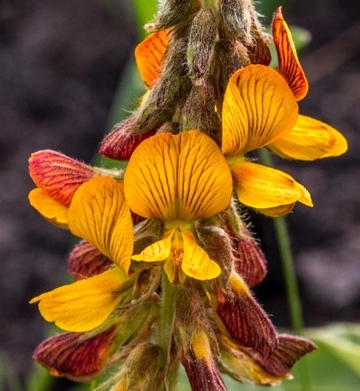
Flowers are large, up to 13–14 mm long, bright brick-red and yellow; the calyx covered in golden hairs. They are typical papilionoid (butterfly-like) pea flowers, with a standard, wing and keel petals. Flowering time is in early summer, from Nov.–Dec.
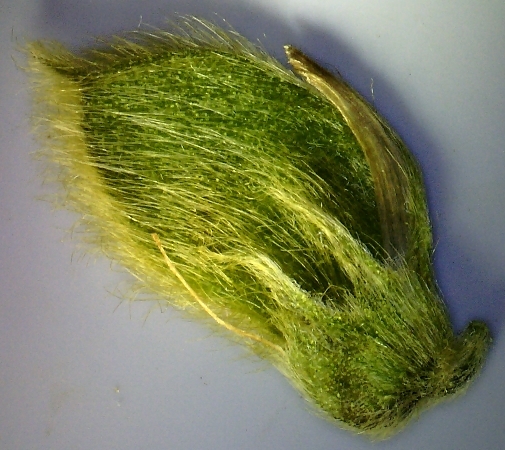
The fruit is a pod, 15–16 × 10–11 mm, densely covered in long, golden hairs lying flat against the surface.
This species has consistently been confused with E. squarrosum, E. dregei, E. latifolium and E. luteopetalum. It differs from all of these species in its red and yellow flowers and golden-haired calyces, whereas the last-named species all have yellow flowers and silver-haired calyces. From E. preptum it can be separated by its much larger flowers and fruits and by the wing petals exceeding the keel petals.
Conservation Status
Status
Eriosema umtamvunense is a rare endemic and is assessed as Endangered (EN) according to the Red List of South African plants. About 60% of the grasslands where this species occurs, has been irreversibly modified, as a result of expanding cultivation of sugarcane, bananas and macadamia nuts, as well as forestry plantations and urban expansion on the coast between Port Edward and Margate. Furthermore, grasslands are continuously being rapidly lost because of an increase in the extent of densely populated rural settlements and associated subsistence agriculture, as well as coastal development, over the past 20 years. Remaining grasslands outside protected areas are also subjected to overgrazing and inappropriate fire management. Recent survey data indicates that this species is more widespread than previously known, although the range is still very restricted.
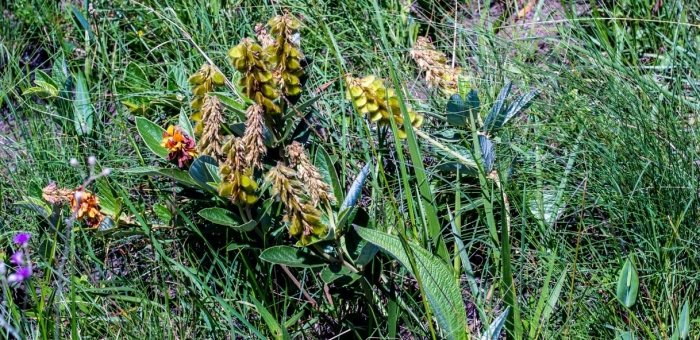
Distribution and habitat
Distribution description
Eriosema umtamvunense is endemic to South Africa. It was thought to be restricted to the plateaux on either side of the Umtamvuna Gorge, on the KwaZulu-Natal and Eastern Cape border, the region known as Pondoland, and is now known to occur along the coast from Margate on the KwaZulu-Natal south coast, to the Mzamba River in the Eastern Cape. It is distributed on the top of the escarpment and grows in coastal grassland and sourveld.
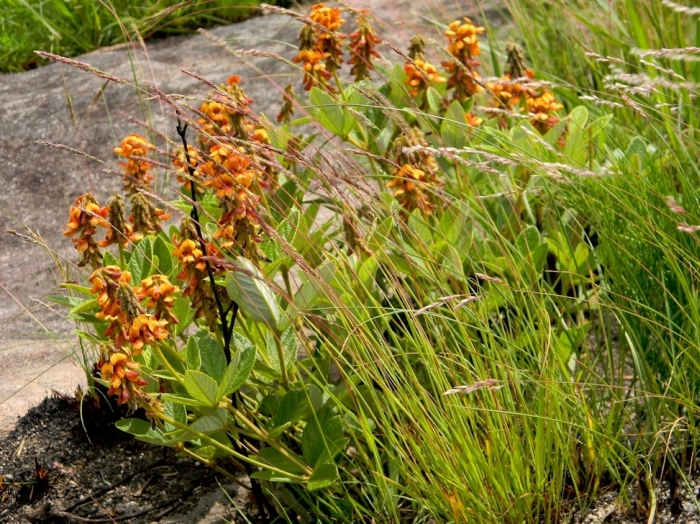
Derivation of name and historical aspects
History
The name Eriosema is derived from the Greek words erion meaning ‘wool’, and semeia, meaning ‘standard’, ‘sign’, ‘mark’ or ‘token’, in reference to the indumentum usually found on the back of the standard petal, in this genus. This species is named after the Umtamvuna River Gorge in the south coast of KwaZulu-Natal, where this species occurs.
The genus Eriosema consists of about 150 species of erect or climbing subshrubs or herbs, found worldwide, but mostly in tropical regions, with 100 species in Africa and about 36 species in South Africa. The plants in this genus possess leaves that are 1- or 3-foliolate, and leaflets that often have small glands underneath. The flowers are reflexed, have a 5-lobed calyx and mainly yellow corolla. The mature seeds of species of Eriosema are characterized by a long, linear hilum (scar) flanked by a conspicuous, whitish, and 2-lobed structure. Because of its prominence on the seed and its distinctive shape and size, it has been found to be a good taxonomic character in helping to characterize the genus, especially in distinguishing it from the closely related genus, Rhynchosia.

Ecology
Ecology
Dull red and yellow flowers attract butterflies and bees in the warm season. Grassland burning encourages seasonal new growth of the plant in spring, as the plant survives the fire, because of its woody rootstock.
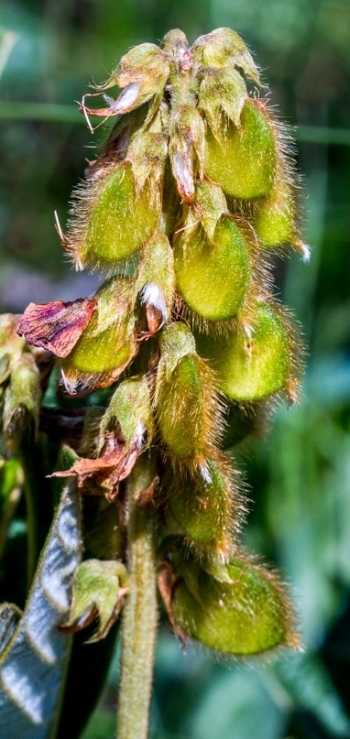
Uses
Use
Although there is no specific documented information about the uses of E. umtamvunense, the plants of the genus Eriosema have several ethnomedical and ethnobotanical uses, besides treatment of infertility and related disorders. These include treatment of diarrhoea, orchitic, hydrophobia, detoxification, conjunctivitis, cough, emetic, and scabies. It is reported that hot milk infusions of roots and pounded root decoctions of E. cordatum, E. distinctum and E. salignum are taken for impotence. Other Eriosema species have been found to be mildly poisonous and have been used for fish poisoning. These include E. glomerata, E. griseum and E. psoraleoides. Plants in this genus are also reported to be used traditionally in a mixture with other plants to stimulate bulls in spring by the Sotho.
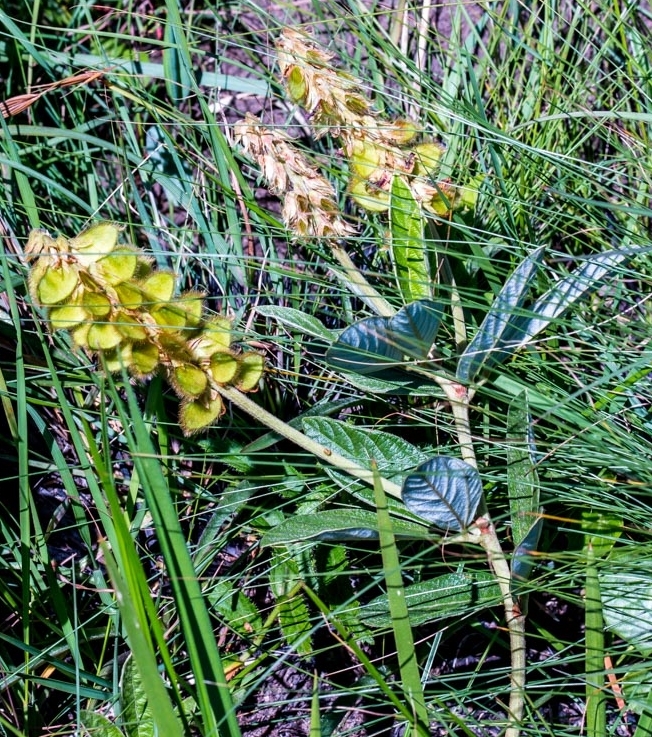
Growing Eriosema umtamvunense
Grow
This species is still unknown in cultivation. It is best propagated from seeds, soaked and/or sandpapered before sowing. Use a well-drained, sterile sowing medium and treat with a fungicide that combats pre- and post-emergence damping off. Cultivation is more suitable in coastal summer rainfall areas, and frost free areas. This species would need a sunny position, in well-drained soil.
References
- Grear, John W. & Dengler, Nancy G. 1976. The seed appendage of Eriosema (Fabaceae). Brittonia, vol. 28, no. 3, pp. 281–288. www.jstor.org/stable/2805789
- Jackson, W.P.U. 1990. Origins and meanings of names of South African plant genera. University of Cape Town.
- Nichols, G. 2005. Growing rare plants: a practical handbook on propagating the threatened plants of southern Africa. Southern African Botanical Diversity Network Report No. 36.
- Nkonki, T., Serumula, S.M. & Condy, G. 2017. Eriosema distinctum. Flowering Plants of Africa 65: 84–89.
- Pooley, E. 2013. A field guide to wild flowers KwaZulu-Natal and the eastern region. Natal Flora Publications Trust, Durban.
- Selepe, M. 2011. Synthesis and analysis of Eriosema isoflavonoids and derivatives thereof. Published Ph.D. Thesis, University of KwaZulu-Natal, Pietermaritzburg. http://researchspace.ukzn.ac.za/handle/10413/6409
- Stirton, C.H. 1986. The Eriosema squarrosum complex (Papilionoideae, Fabaceae) in southern Africa. Bothalia 16(1): 11–22.
- Von Staden, L. 2014. Eriosema umtamvunense C.H.Stirt. National Assessment: Red List of South African plants version 2017.1. Accessed on 2018/12/19.
Credits
Lungisani Zondi
Walter Sisulu National Botanical Garden
January 2019
Acknowledgements: the author thanks Graham Grieve and the CREW Pondoland Team for supplying the images to illustrate this article.
Plant Attributes:
Plant Type: Ground Cover, Shrub
SA Distribution: Eastern Cape, KwaZulu-Natal
Soil type: Sandy, Loam
Flowering season: Early Summer
PH: Acid, Neutral
Flower colour: Red, Yellow
Aspect: Full Sun, Morning Sun (Semi Shade), Afternoon Sun (Semi Shade)
Gardening skill: Average
Special Features:
Horticultural zones







Rate this article
Article well written and informative
Rate this plant
Is this an interesting plant?
Login to add your Comment
Back to topNot registered yet? Click here to register.